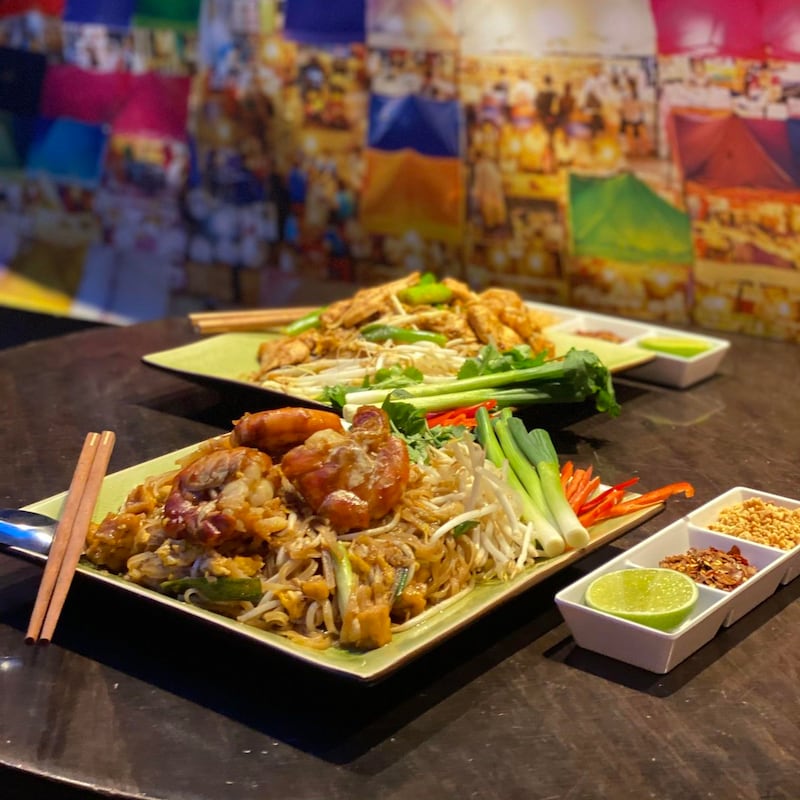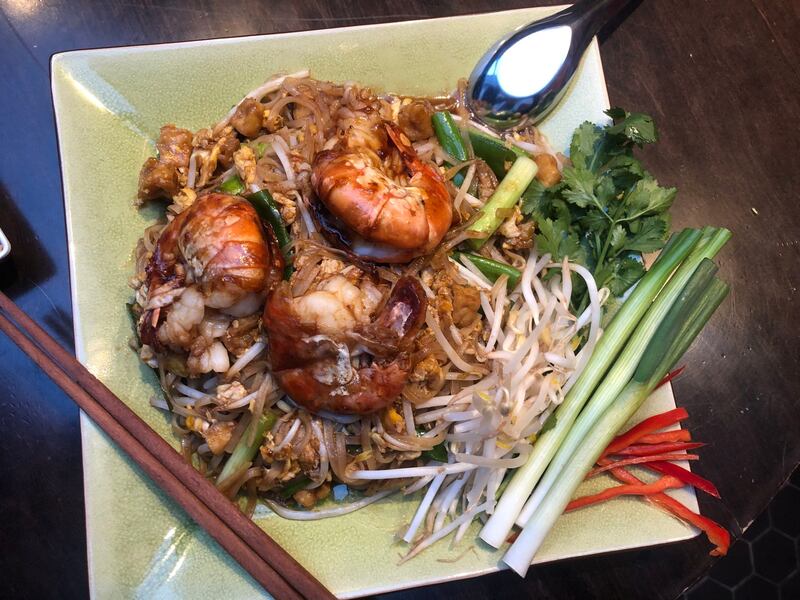Phad Thai, or pad Thai – both spellings are correct – is one of Thailand's best-known dishes and a staple of restaurants specialising in the food from this part of southeast Asia. The stir-fried noodle dish can be easily replicated at home, according to Jutarat Suwankeeree, co-owner of Nightmarket restaurant in Ranelagh, Dublin 6.
“Phad Thai is one of the most popular and famous noodle dishes in Thai cuisine, and fairly easy to make, with the right ingredients,” she says. Key among those ingredients is a special type of rice noodle.
Suwankeeree recommends using 3mm-thick Sen-Chan noodles, which can be sourced in Asian food shops. The texture of these noodles from Chantaburi province is what sets them apart; they retain a good texture in the wok, and don’t break up, she says. If you cannot get them, use any type of rice noodle and follow the packet instructions to rehydrate them, but they may end up softer than the authentic sort in the finished dish.

Suwankeeree, who grew up in the southern coastal city of Hua Hin and also lived in Chiang Mai, in the north, notes that there are regional differences in how the street food is prepared. "Different parts of Thailand cook it in different ways. In Phetchaburi they use prawns, in Bangkok they use pork or chicken, and some places it's just noodles, egg, beansprouts and spring onion."
The sauce that binds the noodles “should taste sweet, sour and slightly salty”, Suwankeeree says. Her recipe for it, below, can be scaled up and will keep for a week in the fridge.
The dish has its origins in the rice shortage that Thailand suffered during the second World War. “The government implemented a new strategic programme introducing and promoting new alternative types of foods, such as noodles derived from rice,” Suwankeeree explains.
“The prime minister at the time, Plaek Phibunsongkhram, favoured noodles very much and strongly believed in their nutritional and economical value. A decree was created encouraging the whole population of Thailand – 18 million at the time – to consume one noodle dish a day.”

The Irish Times recipe archive has two versions of pad Thai, both created by Donal Skehan. The first is a "quick" option, which he acknowledges somewhat controversially does not include tamarind in the ingredients. The other is a vegetarian option. Both incorporate a paste made of garlic, coriander, red chilli and lime.
Recipe: Quick pad Thai
Recipe: Vegetarian pad Thai
Jutarat Suwankeeree’s recipe doesn’t have this, relying instead for that sweet/salty/sour flavour coming from a simple amalgam of palm sugar, Thai fish sauce and tamarind in the sauce. Heat comes through the addition of roasted chilli powder, or chopped fresh red chilli, as part of the finishing condiments.
Nightmarket phad Thai goong (phad Thai with prawns)
Serves 2

Ingredients
Phad Thai sauce:
150ml tamarind water (break off 225g of tamarind pulp, immerse in warm water and leave until soft. Squeeze and work the pulp through a sieve. Make tamarind water quite thick and dilute if needed.
3-4 tbsp palm sugar (heat up in the microwave on low heat until melted)
3-4 tbsp Thai fish sauce
40g Thai rice noodles (if possible 3mm "Sen Chan" rice noodles of particular type and texture from Chantaburi province)
10 large size prawns, head off, skin off, tails on
50g firm yellow tofu, cut into small rectangular shapes
Generous helping of vegetable oil
2-4 duck eggs (may be substituted with free range chicken eggs)
4 banana shallots, finely chopped
50g dried shrimp, soaked in water for 30 minutes, rinsed and dried, optional
Handful of bean sprouts
Handful of Chinese chives or spring onion, chopped into 2 inches stems
To serve: lime wedges, crushed roasted peanuts, roasted chilli powder, fresh red chilli, coriander, bean sprouts to top
Method
1 For the phad Thai sauce, mix all the ingredients in a small pot and bring it to the boil, then leave it to cool down.
2 Soak the noodles in water for two hours, until soft, and then drain them.
3 Heat the oil in a wok on high heat and stir fry the prawns until almost cooked, put aside.
4 Add more oil and stir fry the tofu until it turns a darker colour, put aside.
5 On medium heat fry the shallots until fragrant and starting to caramelise.
6 Add the noodles and stir fry for two minutes. Push to one side of the wok.
7 Turn the heat to high then crack the eggs in the middle of the wok, break the yolk, leave for a few moments, then flip the noodles on the top of the eggs. Leave for a few minutes to cook, flip on the other side and stir a few times.
8 Add prawns, tofu and Phad Thai sauce and simmer until it is absorbed, adding more oil and sauce if necessary. Please note this dish must be moist, not dry.
9 Add the soaked dried shrimps, bean sprouts and Chinese chives or spring onions and stir-fry for a few more minutes.
10 Divide between two plates and serve with more bean sprouts, crushed roasted peanuts, lime wedges and roasted chilli powder on the side of the plates. Also may be served with banana blossom and chopped green mango on the side.



















